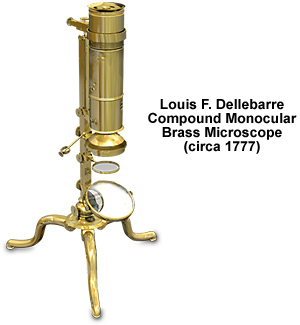Dellebarre Monocular Brass Microscope
This elegantly crafted monocular brass compound microscope was manufactured by Louis F. Dellebarre sometime around 1777. The model featured below was redrawn from photographs of the original microscope, which is part of the Billings microscope collection at Walter Reed Army Hospital in Washington DC.

The microscope is similar in design and execution to Dellebarre's Dutch Microscope made in 1795 and described elsewhere in the museum. A three-leg brass tripod base, attached to the bottom of the square pillar, supports the microscope. Positioned at the lowest portion of the pillar is a substage double mirror, which swings on a gimbal and is attached by a double compass joint. A double convex lens above the mirror serves as a condenser to focus light on a specimen positioned on the circular stage. The stage is hinged to fold upward and is supported on a box slide that is translated with a rack mechanism. A sliding arm holds the body tube using a leather-lined split ring with a spring catch and screw clamp.
The body tube is composed of three sections: a nosepiece for the Lieberkühn reflector and objective, a central support tube, and the eyepiece tube. These sections may be separated to increase the tube length of the microscope. The eye lens is bi-convex and is mounted in a bezeled cell and covered with a screw cap and sliding dust cap. Although not achromatic, the microscope was termed the Universal model.
BACK TO EIGHTEENTH CENTURY MICROSCOPES
